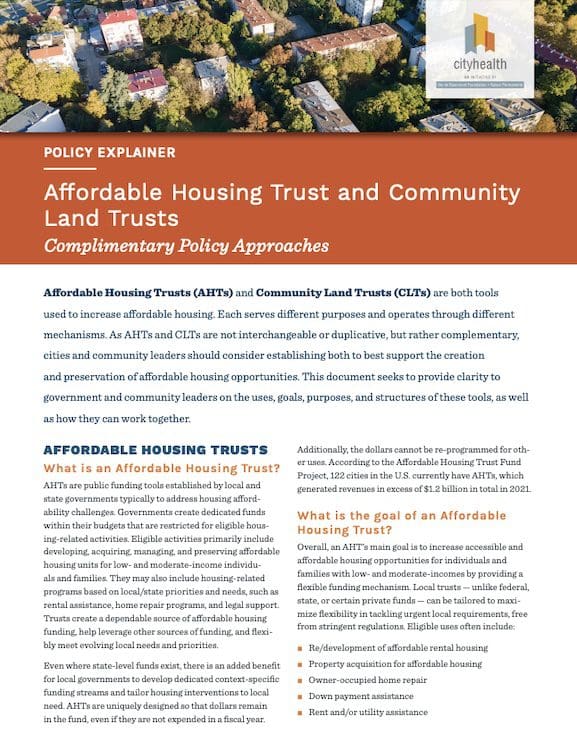Affordable Housing Trusts and Community Land Trusts are both tools used to increase affordable housing. Each serves different purposes and operates through different mechanisms. As Affordable Housing Trusts and Community Land Trusts are not interchangeable or duplicative, but rather complementary, cities and community leaders should consider establishing both to best support the creation and preservation of affordable housing opportunities. This document seeks to provide clarity to government and community leaders on the uses, goals, purposes, and structures of these tools, as well as how they can work together.
Download the full guide here.
Produced in partnership with Enterprise Advisors, the mission-driven consultancy of Enterprise Community Partners.
Affordable Housing Trusts
What is an Affordable Housing Trust?
Affordable Housing Trusts (AHTs) are public funding tools established by local and state governments typically to address housing affordability challenges. Governments create dedicated funds within their budgets that are restricted for eligible housing-related activities. Eligible activities primarily include developing, acquiring, managing, and preserving affordable housing units for low- and moderate-income individuals and families. They may also include housing-related programs based on local/state priorities and needs, such as rental assistance, home repair programs, and legal support. Trusts create a dependable source of affordable housing funding, help leverage other sources of funding, and flexibly meet evolving local needs and priorities.
Even where state-level funds exist, there is an added benefit for local governments to develop dedicated context-specific funding streams and tailor housing interventions to local need. AHTs are uniquely designed so that dollars remain in the fund, even if they are not expended in a fiscal year. Additionally, the dollars cannot be re-programmed for other uses. According to the Affordable Housing Trust Fund Project, 122 cities in the U.S. currently have AHTs, which generated revenues in excess of $1.2 billion in total in 2021.
To begin, read through each section of this guide, think critically about your city, and follow the prompts. Your draft policy should be based in reality, recognizing the environment it will need to be implemented in, but also aspirational — what should the future of mobility look like for your community?
What is the goal of an Affordable Housing Trust?
Overall, an AHT’s main goal is to increase accessible and affordable housing opportunities for individuals and families with low- and moderate-incomes by providing a flexible funding mechanism. Local trusts — unlike federal, state, or certain private funds — can be tailored to maximize flexibility in tackling urgent local requirements, free from stringent regulations. Eligible uses often include:
- Re/development of affordable rental housing
- Property acquisition for affordable housing
- Owner-occupied home repair
- Down payment assistance
- Rent and/or utility assistance
How are Affordable Housing Trusts structured?
Affordable Housing Trusts are typically established through legislation or regulatory ordinances at the municipal or state level. This legal foundation defines the trust’s authority, governance structure, funding mechanisms, and operational scope.
Trust funds often have a governing board or committee responsible for decision-making and oversight. Members of this board may include representatives from local government, housing advocacy groups, community organizations, and sometimes residents directly affected by affordable housing issues. They may prioritize projects based on community needs assessments and affordability criteria. In many cases, government entities often partner with qualified tenant coalitions, developers, nonprofit organizations, or housing agencies to deploy funding rather than self-developing.
How are Affordable Housing Trusts funded?
Affordable Housing Trusts primarily get their funding from public revenue streams, including:
- Developer fees are assessed to developers for new construction to account for their impact on their surroundings.
- Documentation recordation fees are applied per page for documents processed and archived in the public record.
- Real estate transfer fees are charges imposed at the point of a real estate transfer relative to the value of property. Certain municipalities apply real estate transfer fees to transactions above a specified price threshold. These fees may be imposed on either the seller or buyer, or both.
- Short-term rental taxes and fees are often collected on hotel lodging or through short-term rental platforms such as Airbnb and VRBO.
- Local property taxes are levied on the value of real property such as land and buildings, both commercial and residential, or personal property, such as business equipment and noncommercial motor vehicles.
- Recurring appropriations are regular contributions made from a state/local government’s general fund to a dedicated AHT.
Community Land Trusts
What are Community Land Trusts?
Community Land Trusts (CLTs) are nonprofit organizations established with a mission to provide permanent affordable housing opportunities, mostly with an emphasis on homeownership. These entities can do this by acquiring property and rehabbing existing or constructing new structures, offering them at affordable price points, and then finding an income-eligible homebuyer. The buyer purchases the structure from the CLT, while the CLT maintains ownership of the land, providing a (typically 99-year) renewable lease of the land to the buyer. The homebuyer is responsible for paying the mortgage on the house and for upkeep of both the land and structure.
The homeowner then has the right to exclusive use of the property, to bequeath the property and lease, and to sell the house. When the homeowner wishes to sell the home, the CLT sets a new sales price, typically using a formula that balances affordability for buyers and wealth building for the previous owner. Thus, when the home is sold, the previous owner is able to recoup their original investment plus some of the appreciated value of the home.

What is the mission of a Community Land Trust?
The primary goal of CLTs is to provide permanent affordable homeownership opportunities while building community wealth. They can also be used to provide affordable rental housing and commercial properties and to preserve land and greenspace. When a CLT obtains title to a parcel of land, that parcel is permanently removed from the market, while the CLT rehabilitates, builds, and sells the structures on that land in accordance with its stated goals. Additionally, to help realize these goals, CLTs often provide services and resources that support homebuyers before and after purchase, including homebuyer counseling, downpayment assistance, and foreclosure prevention.
How are Community Land Trusts structured?
CLTs are nonprofit organizations that typically operate at a neighborhood, multi-neighborhood, or city level, but can also exist at the county/parish or regional level. Membership in a CLT is open to all residents living within this specified service area. CLTs are governed by a tri-partite board of residents of CLT homes, other community residents, and local government, funder, and nonprofit representatives.
How are Community Land Trusts funded?
Like other nonprofit organizations, CLTs use a diversity of funding sources to make homes available at affordable prices. For rehabilitation and construction, CLTs primarily rely on public funding from grant/loan programs administered by local, county/parish, and state governments. They also utilize funding from philanthropic foundations, private donations, and low-cost financing from community development financial institutions. The funds raised by property leases can also provide an important source of funding, particularly for general CLT operating costs.
How do Affordable Housing Trust Funds and Community Land Trusts compare?
Affordable Housing Trusts and Community Land Trusts both aim to provide affordable housing, but operate in different ways and have different outcomes. A municipal or other government entity should create an AHT to fund government and city affordable housing goals, such as subsidizing rents, constructing housing, or supporting housing-related nonprofits. Community Land Trusts, on the other hand, are nonprofit organizations that community leaders may consider creating to meet neighborhood or local housing goals, specifically through on-the-ground provision of permanently affordable housing units. Therefore, while both models aim to address housing affordability, AHTs provide a more flexible funding tool that can be deployed to address a variety of different housing needs.
| Affordable Housing Trusts | Community Land Trusts | Mission | Provide funding to address housing affordability challenges through the development and preservation of affordable housing and other local housing needs | Provide permanent affordable homeownership opportunities while building community wealth |
|---|---|---|
| Role in affordable housing ecosystem | Provide flexible local funding for affordable housing projects, programs, and initiatives | Rehabilitate, construct, and sell homes at subsidized affordable prices while maintaining land ownership |
| Structure | Government fund with governing board/committee responsible for decision-making and oversight often made of local government, housing advocacy groups, and community organization representatives | Community-driven nonprofit organization with governing board made of residents of CLT homes, other community residents, and local government, funder and nonprofit representatives |
| Common funding sources | Public property tax revenues, developer fees, documentation recordation fees, short-term rental fees, and recurring appropriations | Federal grant programs, affordable housing trusts, philanthropic foundations, private donations, and low-cost financing |
How can they work together?
To support their goal of affordable housing preservation and development, government entities can use funding from their AHTs to provide a substantial and sustainable source of funding to CLTs. A 2023 report from the Lincoln Institute of Land Policy found that just over 20 percent of surveyed CLTs receive external funding from a state AHT, and just over 20 percent receive funding from a municipal or local AHT. Some cities, such as Highland Park, IL, have codified that applications submitted by CLTs for AHT funds receive priority for funding allocations. Other cities, such as Baltimore, MD, set aside portions of their AHT funds exclusively for CLTs. The Baltimore City Department of Housing and Community Development, which stewards the City’s AHT, annually releases a notice of funding availability (NOFA) to distribute a portion of the AHT’s funds exclusively for CLT homeownership projects. Other NOFAs released for Baltimore’s AHT funds also include set aside amounts for CLT projects. CLTs receive the greatest proportion of Baltimore’s AHT funds, totaling $7 million to CLTs, or 28 percent of all AHT funds allocated in 2023.




